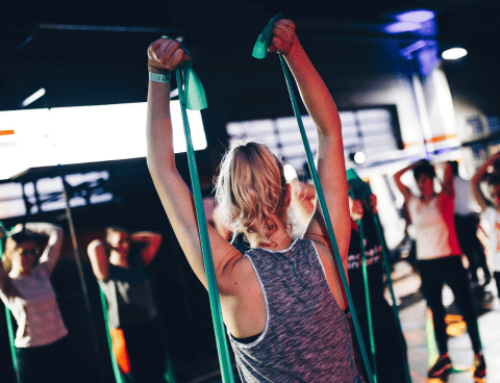Why Learning How to Stick Your Jumps is a Critical Part of Jump Training
This article is part 2 of a four-part series on programming and progressing jump training for field sport athletes. Part one is here.
You want to become an explosive athlete through jump training? Of course you do. However, before you worry about producing maximal force, you must first learn how to absorb the forces generated.
Why is this so important?
Because, unlike many athletes and coaches realize, jump training can be as stressful to your joints as lifting weights—and depending on the exercise, even more stressful. Just check out these peak vertical ground reaction forces witnessed in some of the most popular jump exercises:
- Vertical Jump: 3.34 x body weight
- Broad Jump: 4.22 x body weight
- Depth Jump off 30 cm (12″) box: 2.87 x body weight
- Depth Jump off 60 cm (24″) box: 3.82 x body weight
- Depth Jump off 90 cm (36″) box: 4.93 x body weight
Simply put, a 180-pound athlete can be subjected up to 600 pounds of force landing after a basic Vertical Jump, 760 pounds on a Broad Jump, and almost 900 pounds on a high Depth Jump.
These are considerable loads placed on your lower body every time you jump and come down. If you can’t effectively use your muscles to absorb these forces, your joints have to pick up the slack.
The two most common landing mistakes athletes make include knee valgus (when one or both knees cave in) and rounding of the upper and/or lower back. This is why so many young athletes develop knee and lower back overuse injuries despite never having touched a barbell in their lives. They perform advanced jump variations their bodies are not yet ready for, and use inappropriately high jump volumes combined with bad landing technique to make matters worse.
So how do you teach your body to withstand very high forces upon landing? Before you can handle high forces, you first must be able to handle low forces. Start by grooving your landing mechanics with eccentric-focused exercises like Snapdowns and Depth Drops.
This simple (but often overlooked) step allows you to develop a solid foundation of effective body control and landing mechanics. When you move on to more difficult jump variations down the line, you’ll be able to execute them safely as well.
After you learn correct landing form through these eccentric drills, it’s time to introduce concentric power work into your training sessions.
For that, begin with Box Jumps, Vertical Jumps, Hurdle Hops, Lateral Bounds and other similar, low(er)-intensity movements. Notice that at this stage, every repetition will be performed with a controlled, full stop for one or two seconds before the next rep. This is also called a “stick, stick, stick” sequence because you’re sticking the landing between each rep. Here’s what it looks like:
Note that how these exercises are performed is still more important at this stage than how high, fast or far they are performed. While it can be tempting to dismiss the pause between reps as being “too easy” and skipping straight to rebounding your reps, sticking the landing is actually harder—especially on single-leg exercises. This short isometric hold between each repetition quickly exposes any lack of sufficient eccentric and/or isometric strength. You should be able to come to a full stop without any twisting, turning or shaking. If you’re flapping about like a drunken sailor on your landings, you’re doing it wrong.
Why does this matter?
When performing a sharp cut, turn, or any other type of fast direction change on the field, poor eccentric/isometric strength leads to longer transition times.
On the other hand, if you can apply the breaks and switch course in the blink of an eye, you’ll be much more likely to create time and space for yourself or your teammates in any game situation that requires quick changes of direction.
This is one of the big benefits of jump training few people understand. Everybody’s so focused on who posts the biggest numbers when tested for Vertical or Broad Jumps that we have lost sight of what jump training for field sport athletes really means.
Barring the odd play, there’s no max effort jumping in football, hockey or tennis. And while having the ability to jump high certainly plays a big part in basketball and volleyball, developing greater concentric power is just one piece of the puzzle. If your eccentric and isometric strength aren’t up to snuff, you won’t maximize your quickness on the field, which is the ultimate goal of jump training for field sport athletes.
Yes, seeing your name up there on the gym record board under “Highest Vertical Jump” feels great. As do the pats on the back from your coaches. But it doesn’t really tell anything except that you can generate a high amount of force quickly from a standstill. The only problem is, in most game situations, you don’t start moving from a dead stop position. You must first decelerate before you can accelerate. And if it takes you forever to stop before you take off in another direction, you won’t be very successful on the field despite what that record board reads.
That said, once you can display excellent landing mechanics on unilateral and bilateral jumps by sticking each rep, it’s time to get reactive. For that, you’ll be performing the exact same exercises (such as Vertical Jumps, Hurdle Jumps, Hurdle Hops, Lateral Bounds, etc.) as before. The only difference is that now you’ll be rebounding in a “jump, jump, jump, stick” manner. Here are a few examples of what these movements look like:
These exercises represent what most people refer to as “jump training”. While they’re appropriate choices for intermediate trainees, we need to progress to more advanced drills for developing maximal power and elasticity in advanced athletes. We’ll discuss the exercises and methods for achieving this in Part 3.
References:
Wallace, BJ et al. “Quantification of Vertical Ground Reaction Forces of Popular Bilateral Plyometric Exercises.” Journal of Strength and Conditioning Research. 2010 Jan; 24(1):207-212.
Photo Credit: WoodysPhotos/iStock
READ MORE FROM YUNUS BARISIK:
RECOMMENDED FOR YOU
MOST POPULAR
Why Learning How to Stick Your Jumps is a Critical Part of Jump Training
This article is part 2 of a four-part series on programming and progressing jump training for field sport athletes. Part one is here.
You want to become an explosive athlete through jump training? Of course you do. However, before you worry about producing maximal force, you must first learn how to absorb the forces generated.
Why is this so important?
Because, unlike many athletes and coaches realize, jump training can be as stressful to your joints as lifting weights—and depending on the exercise, even more stressful. Just check out these peak vertical ground reaction forces witnessed in some of the most popular jump exercises:
- Vertical Jump: 3.34 x body weight
- Broad Jump: 4.22 x body weight
- Depth Jump off 30 cm (12″) box: 2.87 x body weight
- Depth Jump off 60 cm (24″) box: 3.82 x body weight
- Depth Jump off 90 cm (36″) box: 4.93 x body weight
Simply put, a 180-pound athlete can be subjected up to 600 pounds of force landing after a basic Vertical Jump, 760 pounds on a Broad Jump, and almost 900 pounds on a high Depth Jump.
These are considerable loads placed on your lower body every time you jump and come down. If you can’t effectively use your muscles to absorb these forces, your joints have to pick up the slack.
The two most common landing mistakes athletes make include knee valgus (when one or both knees cave in) and rounding of the upper and/or lower back. This is why so many young athletes develop knee and lower back overuse injuries despite never having touched a barbell in their lives. They perform advanced jump variations their bodies are not yet ready for, and use inappropriately high jump volumes combined with bad landing technique to make matters worse.
So how do you teach your body to withstand very high forces upon landing? Before you can handle high forces, you first must be able to handle low forces. Start by grooving your landing mechanics with eccentric-focused exercises like Snapdowns and Depth Drops.
This simple (but often overlooked) step allows you to develop a solid foundation of effective body control and landing mechanics. When you move on to more difficult jump variations down the line, you’ll be able to execute them safely as well.
After you learn correct landing form through these eccentric drills, it’s time to introduce concentric power work into your training sessions.
For that, begin with Box Jumps, Vertical Jumps, Hurdle Hops, Lateral Bounds and other similar, low(er)-intensity movements. Notice that at this stage, every repetition will be performed with a controlled, full stop for one or two seconds before the next rep. This is also called a “stick, stick, stick” sequence because you’re sticking the landing between each rep. Here’s what it looks like:
Note that how these exercises are performed is still more important at this stage than how high, fast or far they are performed. While it can be tempting to dismiss the pause between reps as being “too easy” and skipping straight to rebounding your reps, sticking the landing is actually harder—especially on single-leg exercises. This short isometric hold between each repetition quickly exposes any lack of sufficient eccentric and/or isometric strength. You should be able to come to a full stop without any twisting, turning or shaking. If you’re flapping about like a drunken sailor on your landings, you’re doing it wrong.
Why does this matter?
When performing a sharp cut, turn, or any other type of fast direction change on the field, poor eccentric/isometric strength leads to longer transition times.
On the other hand, if you can apply the breaks and switch course in the blink of an eye, you’ll be much more likely to create time and space for yourself or your teammates in any game situation that requires quick changes of direction.
This is one of the big benefits of jump training few people understand. Everybody’s so focused on who posts the biggest numbers when tested for Vertical or Broad Jumps that we have lost sight of what jump training for field sport athletes really means.
Barring the odd play, there’s no max effort jumping in football, hockey or tennis. And while having the ability to jump high certainly plays a big part in basketball and volleyball, developing greater concentric power is just one piece of the puzzle. If your eccentric and isometric strength aren’t up to snuff, you won’t maximize your quickness on the field, which is the ultimate goal of jump training for field sport athletes.
Yes, seeing your name up there on the gym record board under “Highest Vertical Jump” feels great. As do the pats on the back from your coaches. But it doesn’t really tell anything except that you can generate a high amount of force quickly from a standstill. The only problem is, in most game situations, you don’t start moving from a dead stop position. You must first decelerate before you can accelerate. And if it takes you forever to stop before you take off in another direction, you won’t be very successful on the field despite what that record board reads.
That said, once you can display excellent landing mechanics on unilateral and bilateral jumps by sticking each rep, it’s time to get reactive. For that, you’ll be performing the exact same exercises (such as Vertical Jumps, Hurdle Jumps, Hurdle Hops, Lateral Bounds, etc.) as before. The only difference is that now you’ll be rebounding in a “jump, jump, jump, stick” manner. Here are a few examples of what these movements look like:
These exercises represent what most people refer to as “jump training”. While they’re appropriate choices for intermediate trainees, we need to progress to more advanced drills for developing maximal power and elasticity in advanced athletes. We’ll discuss the exercises and methods for achieving this in Part 3.
References:
Wallace, BJ et al. “Quantification of Vertical Ground Reaction Forces of Popular Bilateral Plyometric Exercises.” Journal of Strength and Conditioning Research. 2010 Jan; 24(1):207-212.
Photo Credit: WoodysPhotos/iStock
READ MORE FROM YUNUS BARISIK:











